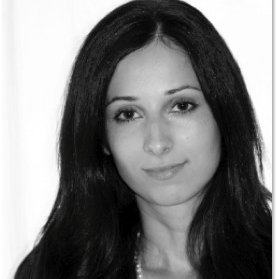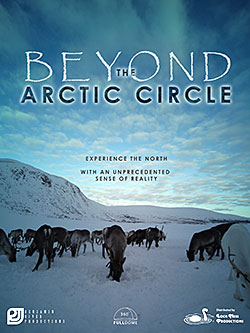An interview with the show’s producer
 Gajane Kalatshjan is the producer of Beyond the Arctic Circle, a fascinating trip to the north, created with her partner Vygantis Kirejevas. They are the principals of Benjamin River Productions, a new fulldome production group headquartered in Vilnius, Lithuania. The live-action show was originally shot at 5K resolution with a custom camera rig, and is now available through Loch Ness Productions. We asked Gajane to share some of her thoughts about creating the show.
Gajane Kalatshjan is the producer of Beyond the Arctic Circle, a fascinating trip to the north, created with her partner Vygantis Kirejevas. They are the principals of Benjamin River Productions, a new fulldome production group headquartered in Vilnius, Lithuania. The live-action show was originally shot at 5K resolution with a custom camera rig, and is now available through Loch Ness Productions. We asked Gajane to share some of her thoughts about creating the show.
LNP: What was the inspiration for the creation of Beyond the Arctic Circle?
GK: When it became technically possible to make an immersive fulldome film about the “real world”, a film about the North was a natural choice for us. It’s on the very edge of the civilized world and only a few people ever get to visit there. It’s amazing how rich the area actually is despite at first sight seeming white and empty. There are the reindeer, the huskies and of course, the Northern Lights.
It is the most magical yet most “down to earth” place that we have ever visited. The reindeer were just so friendly. The night before our first reindeer encounter we watched an episode of Man versus Wild – Arctic Circle where the survivor man, Bear Grylls, was hunting for reindeer and struggling to tame the beast. Suddenly it all seemed quite alarming, knowing that the next morning we were going to track down a herd of those “beasts” in the middle of the vast empty tundra, where it falls dark after 2 p.m. That was very unsettling. However, once we spotted the reindeer and carefully approached them, we managed to get close enough to get some amazing footage. At one point we were completely surrounded by the herd. Thankfully, our camera held up during the long shoot in -40 degrees Celsius temperatures so we could fully capture that amazing experience.
LNP: How much did the immersive space of the dome influence how you shot the video?
GK: Our purpose was to create an immersive film specifically and only for the fulldome medium. It had to take advantage of the dome geometry, utilize the entire dome, and offer a sharp image from edge to edge.
When you are out in the tundra, there are only the Northern Lights that can suddenly appear over your head and the husky-drawn sled that takes you on a roller coaster ride. The time does seem to slow down and that dictated the pace of the film.
We used as few effects as possible and let the audiences be present in the environment with minimal interference.
LNP: Who do you think is the main audience for Beyond the Arctic Circle?
GK: We see families with young children and school groups as the main audience. The story is in the form of a factual fairytale, where the main characters are 9-year-old Simon and his grandfather, who tells a story of an expedition to the North. Along the way we also get to learn the facts about the North and its inhabitants.
The film takes us to the unusual locations in the North. That’s why it is equally appealing also to general audiences. Currently, Beyond the Arctic Circle is the closest alternative to actually traveling there, which makes it a great experience for children as well as adults.
LNP: Many planetariums are in schools and their programs must fit into specific curriculum requirements. What would you tell a teacher about the scientific and cultural principles that this show teaches?
GK: Our aim from the very beginning has been to educate while entertaining. With the new fulldome technologies, it’s possible to achieve high image quality for live-action filming. That lets us expand to the natural sciences, where usually abstract concepts are sometimes difficult to understand. That’s where visualization and concretization can provide real benefits.
 Beyond the Arctic Circle introduces two of the world’s coldest biomes and explains how life can survive in such extreme conditions. It is well suited to be used as an additional study material in such subjects as biology and botany, for example. The show explains what is necessary for life to thrive and demonstrates life’s amazing capabilities to extreme environments. In this film the purpose is not necessarily to give a detailed and comprehensive knowledge about specific subjects but rather to spike interest and expand the understanding of nature’s diversity. Think of it as a virtual field trip to the North where learning takes place directly from the environment.
Beyond the Arctic Circle introduces two of the world’s coldest biomes and explains how life can survive in such extreme conditions. It is well suited to be used as an additional study material in such subjects as biology and botany, for example. The show explains what is necessary for life to thrive and demonstrates life’s amazing capabilities to extreme environments. In this film the purpose is not necessarily to give a detailed and comprehensive knowledge about specific subjects but rather to spike interest and expand the understanding of nature’s diversity. Think of it as a virtual field trip to the North where learning takes place directly from the environment.
The fulldome medium is a perfect fit for educational purposes using natural human curiosity to study directly from the environment. It motivates students to learn more easily. We are currently developing an Immersive Classroom concept to produce content specifically in accordance with school curriculum needs. Our purpose is to produce content on STEM subjects, which helps students in two ways: first, to understand the very basic concepts in natural sciences and second, to deepen the learner’s understanding by demonstrating the connections between the formulas in the textbooks with the surrounding environment. Immersive Classroom will also provide a perfect grounds for introducing students to scientists from different STEM fields in their natural working environments as suitable role models.
LNP: Have you shown this to audiences yet? What was their reaction?
GK: Our big premiere will be this year at Jena Fulldome Festival, however we have shown the film to school kids and smaller audiences locally here in Lithuania as well as to professionals in the field all around the world. Of course, the children loved the huskies, the reindeer and the Northern Lights display, which provides us the most joy. We have received very positive feedback from our colleagues, especially for our image quality. It is what allowed us to create a truly immersive experience.
LNP: Thank you, Gajane!


2 Responses to Behind the Scenes, “Beyond the Arctic Circle”